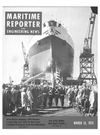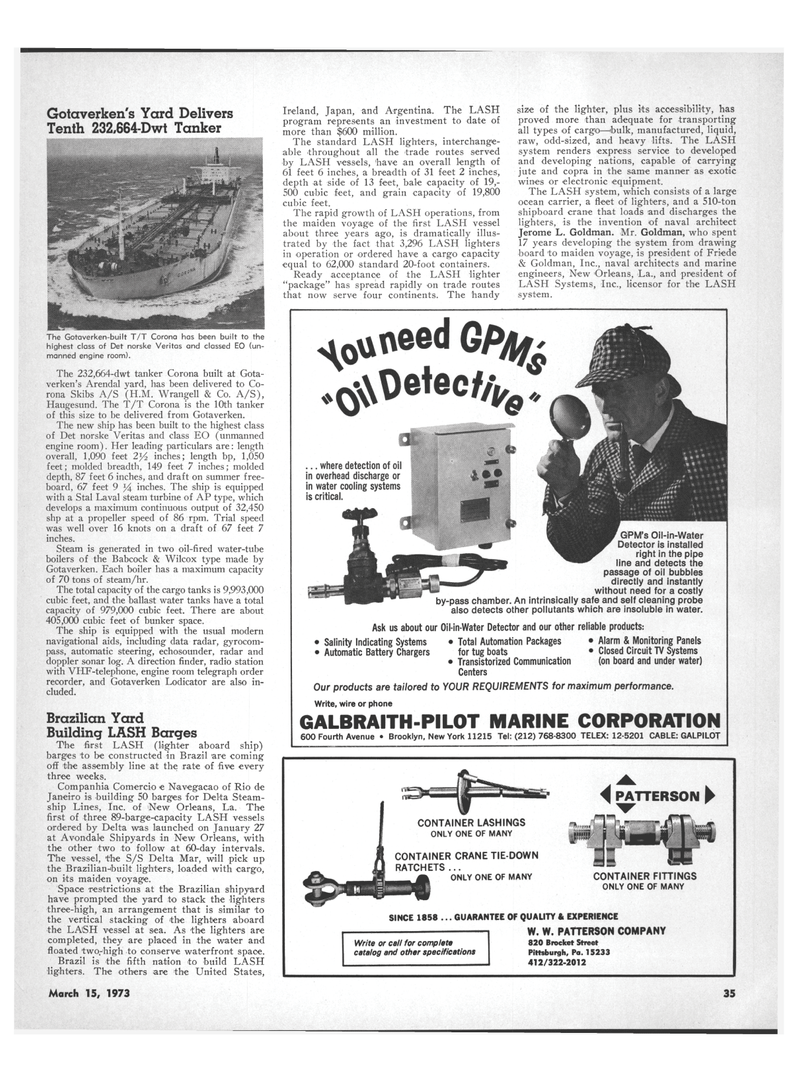
Page 31: of Maritime Reporter Magazine (March 15, 1973)
Read this page in Pdf, Flash or Html5 edition of March 15, 1973 Maritime Reporter Magazine
Gotaverken's Yard Delivers
Tenth 232,664-Dwt Tanker
The Gotaverken-built T/T Corona has been built to the highest class of Det norske Veritas and classed EO (un- manned engine room).
The 232,664-dwt tanker Corona built at Gota- verken's Arendal yard, has been delivered to Co- rona Skibs A/S (H.M. Wrangell & Co. A/S),
Haugesund. The T/T Corona is the 10th tanker of this size to be delivered from Gotaverken.
The new ship has been built to the highest class of Det norske Veritas and class EO (unmanned engine room). Her leading particulars are: length overall, 1,090 feet 2y2 inches; length bp, 1,050 feet; molded breadth, 149 feet 7 inches; molded depth, 87 feet 6 inches, and draft on summer free- board, 67 feet 9 % inches. The ship is equipped with a Stal Laval steam turbine of AP type, which develops a maximum continuous output of 32,450 shp at a propeller speed of 86 rpm. Trial speed was well over 16 knots on a draft of 67 feet 7 inches.
Steam is generated in two oil-fired water-tube boilers of the Babcock & Wilcox type made by
Gotaverken. Each boiler has a maximum capacity of 70 tons of steam/hr.
The total capacity of the cargo tanks is 9,993,000 cubic feet, and the ballast water tanks have a total capacity of 979,000 cubic feet. There are about 405,000 cubic feet of bunker space.
The ship is equipped with the usual modern navigational aids, including data radar, gyrocom- pass, automatic steering, echosounder, radar and doppler sonar log. A direction finder, radio station with VHF-telephone, engine room telegraph order recorder, and Gotaverken Lodicator are also in- cluded.
Brazilian Yard
Building LASH Barges
The first LASH (lighter aboard ship) barges to be constructed in Brazil are coming off the assembly line at the rate of five every three weeks.
Companhia Comercio e Navegacao of Rio de
Janeiro is building 50 barges for Delta Steam- ship Lines, Inc. of New Orleans, La. The first of three 89-barge-capacity LASH vessels ordered by Delta was launched on January 27 at Avondale Shipyards in New Orleans, with the other two to follow at 60-day intervals.
The vessel, the S/S Delta Mar, will pick up the Brazilian-built lighters, loaded with cargo, on its maiden voyage.
Space restrictions at the Brazilian shipyard have prompted the yard to stack the lighters three-high, an arrangement that is similar to the vertical stacking of the lighters aboard the LASH vessel at sea. As the lighters are completed, they are placed in the water and floated two-high to conserve waterfront space.
Brazil is the fifth nation to build LASH lighters. The others are the United States,
Ireland, Japan, and Argentina. The LASH program represents an investment to date of more than $600 million.
The standard LASH lighters, interchange- able throughout all the trade routes served by LASH vessels, have an overall length of 61 feet 6 inches, a breadth of 31 feet 2 inches, depth at side of 13 feet, bale capacity of 19,- 500 cubic feet, and grain capacity of 19,800 cubic feet.
The rapid growth of LASH operations, from the maiden voyage of the first LASH vessel about three years ago, is dramatically illus- trated by the fact that 3,296 LASH lighters in operation or ordered have a cargo capacity equal to 62,000 standard 20-foot containers.
Ready acceptance of the LASH lighter "package" has spread rapidly on trade routes that now serve four continents. The handy size of the lighter, plus its accessibility, has proved more than adequate for transporting all types of cargo—bulk, manufactured, liquid, raw, odd-sized, and heavy lifts. The LASH system renders express service to developed and developing nations, capable of carrying jute and copra in the same manner as exotic wines or electronic equipment.
The LASH system, which consists of a large ocean carrier, a fleet of lighters, and a 510-ton shipboard crane that loads and discharges the lighters, is the invention of naval architect
Jerome L. Goldman. Mr. Goldman, who spent 17 years developing the system from drawing •board to maiden voyage, is president of Friede & Goldman, Inc., naval architects and marine engineers, New Orleans, La., and president of
LASH Systems, Inc., licensor for the LASH system. ^ottoeed GP/if. ^xXOetee/,^ ... where detection of oil in overhead discharge or in water cooling systems is critical.
GPM's Oil-in-Water
Detector is installed right in the pipe line and detects the passage of oil bubbles directly and instantly without need for a costly by-pass chamber. An intrinsically safe and self cleaning probe also detects other pollutants which are insoluble in water.
Ask us about our Oil-in-Water Detector and our other reliable products:
Salinity Indicating Systems • Total Automation Packages • Alarm & Monitoring Panels • Closed Circuit TV Systems (on board and under water)
Automatic Battery Chargers for tug boats • Transistorized Communication
Centers
Our products are tailored to YOUR REQUIREMENTS for maximum performance.
Write, wire or phone
GALBRAITH-PILOT MARINE CORPORATION 600 Fourth Avenue • Brooklyn, New York 11215 Tel: (212) 768-8300 TELEX: 12-5201 CABLE: GALPILOT
CONTAINER LASHINGS
ONLY ONE OF MANY
CONTAINER CRANE TIE-DOWN
RATCHETS ...
ONLY ONE OF MANY 4 PATTERSON •
CONTAINER FITTINGS
ONLY ONE OF MANY
SINCE 1858 ... GUARANTEE OF QUALITY & EXPERIENCE
W. W. PATTERSON COMPANY 820 Brocket Street
Pittsburgh, Pa. 15233 412/322-2012
Write or call for complete catalog and other specifications
March 15, 1973 35

 30
30

 32
32
